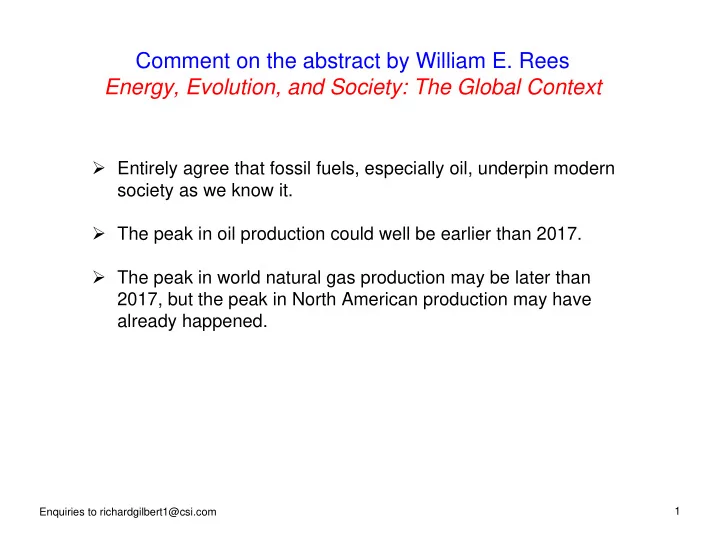

Comment on the abstract by William E. Rees Energy, Evolution, and Society: The Global Context � Entirely agree that fossil fuels, especially oil, underpin modern society as we know it. � The peak in oil production could well be earlier than 2017. � The peak in world natural gas production may be later than 2017, but the peak in North American production may have already happened. 1 Enquiries to richardgilbert1@csi.com
Worldwide discovery of and demand for oil and natural gas Source: Harry J. Longwell, Exec. VP, Exxon Mobil Corp., Offshore Technology Conference, Houston, Texas, May 7, 2002 (http://www.exxon.mobil.com/files/corporate/hjlslide5.pdf) 2 Enquiries to richardgilbert1@csi.com
Worldwide production of oil and natural gas liquids Note: P-NGL refers to propane and other natural gas liquids Source: Uppsala Hydrocarbon Depletion Study Group (http://www.isv.uu.se/uhdsg/) 3 Enquiries to richardgilbert1@csi.com
Billion Cubic Feet Per Day 2001 $/MMBTU 70 $10 Actual Forecast Actual Actual Forecast Forecast U.S. use, production, $9 imports, and price of 65 natural gas $8 60 Consumption Consumption Imports $7 & Other 55 $6 50 $5 Production Production $4 45 Source: Presentation by Henry Groppe of Groppe, Long, Little, $3 at the Executive Oil Conference, Midland, Texas, April 2002 (http://www.petroleumstrategies.com/eocpresentations/2002/Groppe.ppt) 40 $2 Average Wellhead Price Average Wellhead Price 35 (Right Scale) (Right Scale) $1 30 $0 1970 1975 1980 1985 1990 1995 2000 2005 2010 4 Enquiries to richardgilbert1@csi.com
Active rigs and natural gas production, U.S. lower-48 Source: Figure 30 of Balancing Natural Gas Policy (Volume 1). U.S. National Petroleum Council, October 2003. (http://www.npc.org/NG_Volume_1.pdf) 5 Enquiries to richardgilbert1@csi.com
Comment on the abstract by David Layzell The Carbon Cycle and Biosphere Solutions for Climate Change and on the abstract by Heather Smith The Kyoto Protocol: Bringing the Environment Back In � Climate change seems to be occurring, and human activity may well be contributing to it. � But the focus on reducing greenhouse gas emissions may be obscuring the challenges posed by the extraction peaks in oil and natural gas. � Addressing climate change and energy constraints may require similar strategies, but the political message re. energy constraints may be more compelling. � Some of IPCC’s upper-extreme scenarios may not be plausible in the light of fossil-fuel extraction peaks. 6 Enquiries to richardgilbert1@csi.com
Comment on the abstract by Don Johnston Nuclear Energy � Like fossil fuel combustion, nuclear fission is a naturally occurring process that has been harnessed in the quest to provide modern humans with ‘energy slaves’. � Also as with fossil fuel combustion, the major challenges are management of waste products and the vulnerability inherent in massive reliance on added energy. (Don Johnston’s abstract addresses neither of these concerns.) � The prognosis for effective management of nuclear wastes is not good. They have been a major concern for 40 years, and yet no satisfactory solution is in sight (not even the proposed Yucca Mountain geologic repository). 7 Enquiries to richardgilbert1@csi.com
Primary energy other than food, sun, and wind: consumption and efficiency of use, 1900 and 2000 Canada and U.S. Rest of world 1900 2000 1900 2000 Primary energy consumption : per capita (gigajoules) 113 365 17 52 per unit of GDP (kJ per 2000US$) 21.4 10.0 25.4 7.3 Population (billions) 0.08 0.31 1.57 5.74 GDP (trillions of 2000US$) 0.43 11.38 1.05 40.77 GDP/capita (thousands of 2000US$) 5,375 36,710 670 7,105 This table is compiled from numerous sources, available on request A person’s annual manual labour is equivalent to less than one gigajoule of applied energy. Thus, energy use in Canada and the U.S. in 2000 provided each resident with the manual labour equivalent of at least 365 additional people. 8 Enquiries to richardgilbert1@csi.com
Comment on the abstract by David Sanborn Scott The Architecture of Energy Systems: What’s constant, what changes, where are we going, why hydrogen? � Sustainable carbon-free hydrogen would likely be made using electrolysis powered by solar or wind-generated electricity (although algal photosynthesis and other bioprocesses may be candidates). � In the context of major energy constraints, the energy-wasteful conversion of one energy carrier (electricity) into another (hydrogen) would be questioned. � The only strong reason for producing hydrogen may be that it could be more portable than electricity, and thus more capable of fuelling untethered vehicles. � Tethered vehicles provide for by far the most efficient use of electricity, and thus are more consistent with energy constraints. 9 Enquiries to richardgilbert1@csi.com
Comment on the abstract by Alan Amey Climate change opportunities in the hydrocarbon sector � Both emission-reduction technologies and renewables should receive massively expanded research and development. � However, the focus should be on reducing energy intensities rather than reducing emissions, in order to prepare for energy constraints. � The greatest challenges may be in the transport sector, in which— unlike other sectors—energy use per unit of effective output (e.g., per passenger-kilometre) has hardly changed in decades. � Tethered vehicles offer the most promise because of their low energy use and because they can make use of many sources of primary energy (i.e., the energy used to generate the electricity). � Accordingly, research and development for massive deployment of tethered transport systems should receive high priority. 10 Enquiries to richardgilbert1@csi.com
Recommend
More recommend